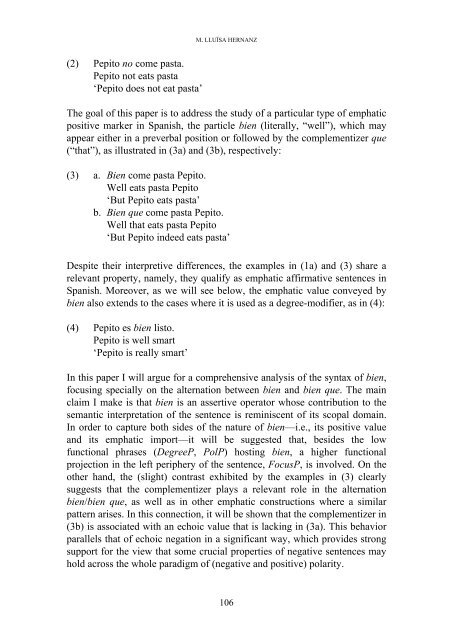Emphatic Polarity and C in Spanish - Lear
Emphatic Polarity and C in Spanish - Lear
Emphatic Polarity and C in Spanish - Lear
You also want an ePaper? Increase the reach of your titles
YUMPU automatically turns print PDFs into web optimized ePapers that Google loves.
(2) Pepito no come pasta.<br />
Pepito not eats pasta<br />
‘Pepito does not eat pasta’<br />
M. LLUÏSA HERNANZ<br />
The goal of this paper is to address the study of a particular type of emphatic<br />
positive marker <strong>in</strong> <strong>Spanish</strong>, the particle bien (literally, “well”), which may<br />
appear either <strong>in</strong> a preverbal position or followed by the complementizer que<br />
(“that”), as illustrated <strong>in</strong> (3a) <strong>and</strong> (3b), respectively:<br />
(3) a. Bien come pasta Pepito.<br />
Well eats pasta Pepito<br />
‘But Pepito eats pasta’<br />
b. Bien que come pasta Pepito.<br />
Well that eats pasta Pepito<br />
‘But Pepito <strong>in</strong>deed eats pasta’<br />
Despite their <strong>in</strong>terpretive differences, the examples <strong>in</strong> (1a) <strong>and</strong> (3) share a<br />
relevant property, namely, they qualify as emphatic affirmative sentences <strong>in</strong><br />
<strong>Spanish</strong>. Moreover, as we will see below, the emphatic value conveyed by<br />
bien also extends to the cases where it is used as a degree-modifier, as <strong>in</strong> (4):<br />
(4) Pepito es bien listo.<br />
Pepito is well smart<br />
‘Pepito is really smart’<br />
In this paper I will argue for a comprehensive analysis of the syntax of bien,<br />
focus<strong>in</strong>g specially on the alternation between bien <strong>and</strong> bien que. The ma<strong>in</strong><br />
claim I make is that bien is an assertive operator whose contribution to the<br />
semantic <strong>in</strong>terpretation of the sentence is rem<strong>in</strong>iscent of its scopal doma<strong>in</strong>.<br />
In order to capture both sides of the nature of bien—i.e., its positive value<br />
<strong>and</strong> its emphatic import—it will be suggested that, besides the low<br />
functional phrases (DegreeP, PolP) host<strong>in</strong>g bien, a higher functional<br />
projection <strong>in</strong> the left periphery of the sentence, FocusP, is <strong>in</strong>volved. On the<br />
other h<strong>and</strong>, the (slight) contrast exhibited by the examples <strong>in</strong> (3) clearly<br />
suggests that the complementizer plays a relevant role <strong>in</strong> the alternation<br />
bien/bien que, as well as <strong>in</strong> other emphatic constructions where a similar<br />
pattern arises. In this connection, it will be shown that the complementizer <strong>in</strong><br />
(3b) is associated with an echoic value that is lack<strong>in</strong>g <strong>in</strong> (3a). This behavior<br />
parallels that of echoic negation <strong>in</strong> a significant way, which provides strong<br />
support for the view that some crucial properties of negative sentences may<br />
hold across the whole paradigm of (negative <strong>and</strong> positive) polarity.<br />
106

















